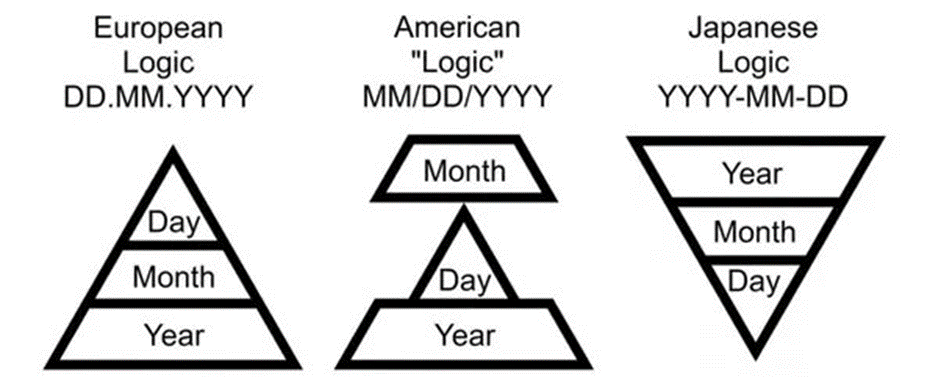Which of the following is the correct way to write the date in the American format?
2/20/2024
20/2/2024
2024/2/20
2024/20/2
The Correct Answer is A
Choice A reason: The American format for writing dates is month/day/year, so 2/20/2024 is the correct way to write the date February 20, 2024.

Choice B reason: The European format for writing dates is day/month/year, so 20/2/2024 is not the correct way to write the date in the American format.
Choice C reason: The ISO format for writing dates is year/month/day, so 2024/2/20 is not the correct way to write the date in the American format.
Choice D reason: This is an invalid format for writing dates, as there is no month with 20 days.
Nursing Test Bank
Naxlex Comprehensive Predictor Exams
Related Questions
Correct Answer is B
Explanation
Choice A reason: Leukemia is not a probable condition, as it is a cancer of the white blood cells that causes abnormal proliferation and accumulation of immature or dysfunctional white blood cells. The child has a high WBC count, which can indicate leukemia, but not necessarily. The child does not have other signs of leukemia, such as bleeding, bruising, bone pain, or lymphadenopathy.
Choice B reason: Sickle cell anemia is a possible condition, as it is an inherited disorder that affects the shape and function of the red blood cells, causing them to become sickle-shaped and rigid. The child has a low Hgb and Hct, which can indicate anemia, and a fever, tachycardia, and low oxygen saturation, which can indicate a sickle cell crisis. A sickle cell crisis is a condition where the sickle-shaped red blood cells block the blood flow and cause tissue ischemia and inflammation.
Choice C reason: Hemophilia is not a likely condition, as it is an inherited disorder that affects the clotting factors, causing impaired blood clotting and increased risk of bleeding. The child has a low Hgb and Hct, which can indicate anemia, but not necessarily hemophilia. The child does not have other signs of hemophilia, such as bleeding, bruising, hemarthrosis, or hematuria.
Choice D reason: Iron deficiency anemia is not a definite condition, as it is a type of anemia that occurs when the body does not have enough iron to produce hemoglobin, the protein that carries oxygen in the blood. The child has a low Hgb and Hct, which can indicate iron deficiency anemia, but not necessarily. The child does not have other signs of iron deficiency anemia, such as pallor, fatigue, weakness, or pica.
Correct Answer is C
Explanation
Choice A reason: A 2-year-old toddler is not a recommended recipient of the MCV4 vaccine, as it is not routinely given to children younger than 11 years old, unless they have certain medical conditions that increase their risk of meningococcal disease, such as asplenia, complement deficiency, or HIV infection. A 2-year-old toddler may receive the meningococcal polysaccharide (MPSV4) vaccine instead, if indicated.
Choice B reason: A 4-month-old infant is not a recommended recipient of the MCV4 vaccine, as it is not routinely given to children younger than 11 years old, unless they have certain medical conditions that increase their risk of meningococcal disease, such as asplenia, complement deficiency, or HIV infection. A 4-month-old infant may receive the meningococcal serogroup B (MenB) vaccine instead, if indicated.
Choice C reason: An 11-year-old school-age child is a recommended recipient of the MCV4 vaccine, as it is routinely given to children aged 11 to 12 years old, with a booster dose at age 16. The MCV4 vaccine protects against four types of meningococcal bacteria (A, C, W, and Y) that can cause serious infections of the lining of the brain and spinal cord (meningitis) or the bloodstream (septicemia).
Choice D reason: A 4-year-old child is not a recommended recipient of the MCV4 vaccine, as it is not routinely given to children younger than 11 years old, unless they have certain medical conditions that increase their risk of meningococcal disease, such as asplenia, complement deficiency, or HIV infection. A 4-year-old child may receive the meningococcal polysaccharide (MPSV4) vaccine instead, if indicated.
Whether you are a student looking to ace your exams or a practicing nurse seeking to enhance your expertise , our nursing education contents will empower you with the confidence and competence to make a difference in the lives of patients and become a respected leader in the healthcare field.
Visit Naxlex, invest in your future and unlock endless possibilities with our unparalleled nursing education contents today
Report Wrong Answer on the Current Question
Do you disagree with the answer? If yes, what is your expected answer? Explain.
Kindly be descriptive with the issue you are facing.
